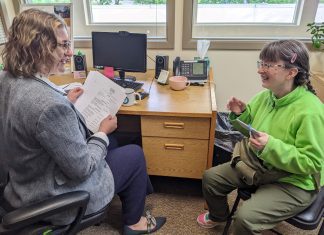Whether it’s an injury sustained during physical activity or the rigors of arthritis, issues with your feet or ankles can cause a lot of pain and frustration—keeping you from full mobility and the life you want to lead.
When these kinds of problems arise, a trip to PeaceHealth Orthopedics and Sports Medicine in Bellingham can yield solutions. Their multidisciplinary team of orthopedic surgeons, sports medicine specialists, nurses and assistants work together to provide comprehensive care in a single location, whether treatment is surgical or non-surgical in nature.
Operation Determination

Dr. Carter Kiesau, an orthopedic surgeon with 16 years of experience, specializes in foot and ankle procedures with a special interest in arthritis prevention and sports injuries. The most common foot or ankle injuries span across all age groups, and include sprains and fracture of bones, and tears and ruptures of various ligaments and tendons.
Not all injuries require surgery, however.
Many ankle sprains, for instance, don’t require surgery, Dr. Kiesau says, as many ligaments are good at healing themselves. Sprains that may need surgery, meanwhile, depend on the structural and functional natures of the injury.
“If someone has an ankle fracture where there’s significant displacement of the fracture, or the joint or the cartilage is displaced, those tend to be things that need surgery,” says Dr. Kiesau.
Sports-related stress fractures can also require surgery, especially if fractures are of the fifth metatarsal or the navicular bone—a boat-shaped bone in the middle of the foot. A Lisfranc fracture, where one or more metatarsal bones are separated from the tarsus—the cluster of bones in the back-half of the foot—is another fracture that often necessitates surgery.

Cartilage injuries can also require ankle surgery, but in any case, Dr. Kiesau says it’s always important to see a patient and determine a very exact extent of injuries, often using special X-rays or an MRI to help with the diagnosis.
Most ankle and foot surgeries, especially those that are sports-related, are outpatient procedures done with general anesthesia. This means the patient is sent home the same day as the procedure and, in many cases, is able to walk that same day. Dr. Kiesau says that for most patients, the goal to get them putting weight on their foot or ankle as soon as possible. Moving around also decreases the risk of surgery complications like blood clots or venous stasis—a pooling of blood in the veins.
Recovery times vary.
“It kind of depends on the injury, the surgery, and what we can allow afterwards,” says Dr. Kiesau.

In the case of surgery for a ruptured Achilles tendon, for example, patients are fitted with a boot that lifts up their heel, allowing them not to stretch the freshly-repaired tendon. They then walk on the boot while using crutches.
Some repairs, however, still require time off your feet. A Lisfranc fracture repair features screws in the repaired area that need time to strengthen. This usually keeps a patient off the affected foot for four to six weeks. Some ankle fractures also can entail this same amount of healing time.
Arthritis
In the case of arthritis-based issues of the foot or ankle, there are multiple non-surgical methods to consider first.
These include steroid shots into a joint, various types of braces, and physical therapy. Dr. Kiesau says doctors can suggest what activities a person should do to prolong their remaining good cartilage, helping delay surgery. When surgery does become necessary, options include fusion surgery—where the ankle joint is operated on to help it fuse together—or total ankle replacement with an artificial joint.

Generally, Dr. Kiesau says, a fusion procedure is a good option for younger patients, as a full replacement means the joint will eventually wear out again, requiring more surgeries down the road.
For older patients, a full ankle joint replacement is often recommended, and functions much like a knee or hip replacement. In surgery, precise incisions are made in a patient’s ankle using specialized instruments. The old joint is removed and replaced with an implant sized specifically to the patient.
“It’s kind of like a sandwich,” Dr. Kiesau says of the implant. “Each piece of bread is a metal component that is highly polished and smooth, and each of those is on the top and bottom of the ankle joint. And in between, we have polyethylene that is kind of like the cartilage of the artificial ankle, and allows the motion and gliding to happen.”

Currently, ankle replacement may require a patient to stay off their new joint for about two weeks for healing purposes, and walking in a boot after that. This is far better than previous arthritis-based ankle fusion, which typically put patients off their foot for 10 to 12 weeks.
“The technology is always getting better,” Dr. Kiesau says of surgeries. “Total knee and total hip replacements have been around for a long time and they’ve been good for a long time. Total ankles are a newer technology that’s still getting better and better in short periods of time. It’s kind of an exciting time for people with ankle problems.”
Bunions
Another common issue is bunions, which are bony bumps that form on the joint at the base of the big toe. These deformities can affect all age groups, and affect a person’s running, exercising, and even shoe-wearing abilities.
This is another area where new technologies have refined surgical techniques. Previously, Dr. Kiesau says standard surgery required a patient to remain off their foot completely for six to eight weeks. Now, with stronger implants, patients can often put weight on their foot in a walking boot the same day they have surgery.
“That’s a game-changer for a lot of patients of mine,” he says. “Not having to use a knee scooter or wheelchair or something because they can’t walk on their foot for two months.”
If you’re searching for additional trustworthy information on foot and ankle injuries and how surgery might affect you, Dr. Kiesau recommends visiting footcaremd.org, a patient-friendly website from the American Orthopaedic Foot & Ankle Society.
Sponsored







































